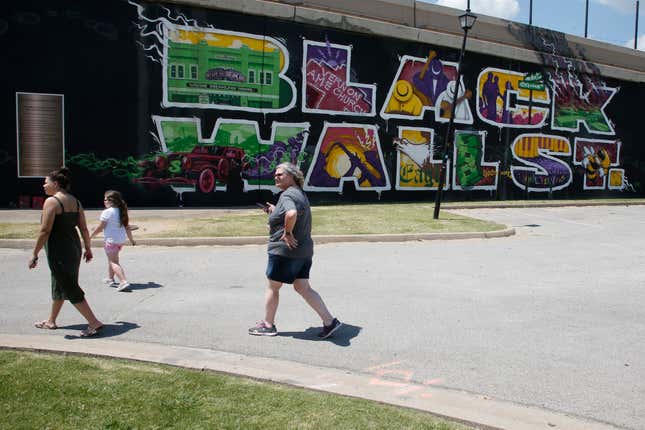
The city of Tulsa has ordered that a Black Lives Matter mural, painted on a street in the district where the Black Wall Street massacre happened nearly 100 years ago, be painted over.
The Wednesday night decision came after chairman of the Tulsa Republican Party, Bob Jack, emailed his city councilor last week, stating interest in having a pro-police “Back the Blue” mural painted, reports KJRH TV. According to the local news station, Jack posed it as a rhetorical question—”he said he was already aware the city had no set process regarding street paintings.”
Jack also proposed a mural that read “Baby Lives Matter,” the Washington Post writes.
The painting was never officially approved by the city of Tulsa; Jack’s request forced council members to consider how they could allow the BLM message to stand, but not a “Back the Blue” or other right-wing, pro-police message.
“I applaud it,” Councilor Connie Dodson said regarding the BLM mural at Wednesday’s meeting, the Post reports. “It’s great. But at the same point, it comes down to: Yes, if you allow one, then you have to allow all of them.”
The mural, painted on the street in bold yellow block letters in Tulsa’s Greenwood district (similar to how Black Lives Matter Plaza looks in Washington, D.C.), was painted by artists and volunteers on June 18, one the eve of Juneteenth and two days before President Donald Trump’s scheduled visit to the city, according to CNN. Ryan Rhoades, the artist who organized the painting, told KOKI TV that he never meant for the mural to last a long time. In fact, when painters purchased the chalk-based paint, they were told it would wash away with the rain.
But the mural endured, becoming the site of demonstrations and selfies in a neighborhood with a rich, fraught history.
The Greenwood district, also known as Black Wall Street, was the most prosperous Black neighborhood of its time. As the Post notes, the community was unique for its concentration of Black wealth: Black Tulsans could visit Black doctors and lawyers there, dine at Black-owned restaurants, see films in Black-owned theaters and buy luxury items from Black-owned stores. But after a white mob violently attacked the district in 1921, the neighborhood was burned to the ground and more than 10,000 residents were displaced.
Nearly a 100 years later, Greenwood is still fighting to get proper investment back into the neighborhood. A “Rebuild Greenwood” GoFundMe launched at the beginning of the year by the Greenwood Chamber of Commerce sought to raise $1 million to go toward urgent structural updates to historic buildings. It has raised just under $35,000 as of July 31.
Briana Shea, who helped organize the Black Lives mural painting, told Tulsa World she was disheartened by the decision-making process the city went through.
“I am kind of disappointed that it was left up to a city vote, not a community vote, because it was all based around community and community (donated) dollars, not city dollars,” Shea said. To her, the mural provided a necessary rallying point during a difficult time for the city’s Black residents.
“Having that painted there as Trump flew into Tulsa and he was able to see that, I think it says a lot about Tulsa and our history here and how we are not proud of the history but we wanted to make it known that 99 years later we’re still healing from it, and I thought that mural that we did bring healing.”
Jack, whose rhetorical question led to the impending removal of the BLM mural, said he wasn’t opposed to the painting itself.
“An appropriate manner is go on your building, go on your property,” he said. “Go someplace that is not public property and voice your opinion.”
_______________________________________________
Join the discussion! The Root is hosting its first-ever, virtual Root Institute, presented by Target, featuring several of the leading minds in our community talking about politics, culture, health, community building and social impact. Subscribe for updates today!

